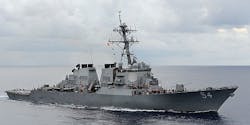Lockheed Martin, Raytheon, move forward with weapons systems upgrades on Navy cruisers and destroyers
WASHINGTON, 31 March 2015. U.S. Navy shipboard electronics experts are moving forward with projects to upgrade the Aegis combat system aboard Navy destroyers and cruisers to enhance radar speed and performance against advanced threats like cruise missiles, ballistic missiles, and high-performance attack aircraft.
Officials of the Naval Sea Systems Command in Washington awarded two contracts Friday -- one to Lockheed Martin Corp. and the other to Raytheon Co. -- related to the Navy's Aegis Modernization (AMOD) program to upgrade combat systems aboard Arleigh Burke-class destroyers and Ticonderoga-class cruisers.
The Lockheed Martin Mission Systems and Training segment in Moorestown, N.J., won a $51.6 million contract modification, while Raytheon won $16.7 million contract modification, both related to Multi-Mission Signal Processor (MMSP) equipment aboard Aegis cruisers and destroyers.
The MMSP provides anti-air warfare (AAW)) and ballistic missile defense (BMD) capability for cruiser and destroyer Aegis systems. MMSP modifies transmitters of the SPY-1D radar to enable dual-beam operation for reduced frame times and better reaction time, and provides stability for all D(V) waveforms.
The SPY-1 radar system detects, tracks, and supports engagements of a broad range of aircraft, cruise missile, and ballistic threats. MMSP improves performance in littoral, ducted clutter environments, and in electronic attack, and chaff environments and provides greater commonality in computer programs and equipment.
Related: Navy steps out on MODERNIZATION
Lockheed Martin will produce MMSP equipment sets; ballistic missile defense 4.0.2 equipment; Aegis weapon system AMOD upgrade equipment; spare parts; special tooling; and test and measurement equipment related to AMOD upgrades.
The Raytheon Integrated Defense Systems segment in Sudbury, Mass., meanwhile, will provide MMSP ordnance alteration (ORDALT) kits; kill assessment system ORDALT kits; RF coherent combiner kits; high-voltage power supply sidewall capacitors; traveling waves tube monitoring circuits;stabilized master oscillator ORDALT kits; and test and installation related to AMOD upgrades.
For its contract, Lockheed Martin will do the work in Moorestown, N.J.; Clearwater, Fla.; and Owego, N.Y., and should be finished by July 2017. Raytheon will do its work in Norfolk, Va.; as well as in Andover, Burlington, and Sudbury, Mass., and should be finished by May 2017.
For more information contact Lockheed Martin Mission Systems and Training online at www.lockheedmartin.com/us/mst, Raytheon Integrated Defense Systems at www.raytheon.com, or Naval Sea Systems Command at www.navsea.navy.mil.

John Keller | Editor
John Keller is editor-in-chief of Military & Aerospace Electronics magazine, which provides extensive coverage and analysis of enabling electronic and optoelectronic technologies in military, space, and commercial aviation applications. A member of the Military & Aerospace Electronics staff since the magazine's founding in 1989, Mr. Keller took over as chief editor in 1995.

